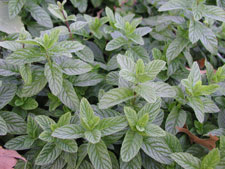Resource Library
Plant of the Week: Spearmint
The University of Arkansas System Division of Agriculture does not promote, support or recommend plants featured in "Plant of the Week." Please consult your local Extension office for plants suitable for your region.
Plant of the Week
Spearmint
Latin: Mentha spicata

Two hundred years from now some publisher - maybe providing the information in brain waves fed directly into the minds of growing children - will credit the invention of the computer to two or three individuals. We like short, clear and concise explanations.
But, as you know, big discoveries are built from a series of smaller, oftentimes seemingly unrelated events. Using a mint plant, the Englishman Joseph Priestley (1733 - 1804) is usually given the credit for discovering photosynthesis, but this too is only an approximation of what really happened.
Spearmint, Mentha spicata, is a fast growing, often invasive, rhizomatous perennial herb in the mint family that gives off the characteristic minty aroma when crushed. Like all plants in the mint family it has square stems and opposite, 2-inch long leaves arranged alternately up the stem.
Blue, pink or white flowers appear in the spring and early summer in erect spikes and are favorites of bees. Spearmint has been cultivated throughout recorded history and is naturalized throughout Europe, so its place of origin is unknown.
It was probably the very commonness of mint leading Priestley to choose it for the continuation of his research on gasses. Priestley, a theologian by training with a liberal, enquiring mind, became interested in gasses when he lived next to a beer brewery. He found the gas given off by the fermenting grain (carbon dioxide) was heavier than air and capable of extinguishing the flames of a wood chip fire.
In August 1771, Priestley placed a lighted candle and a mint plant in a sealed bell jar. The candle quickly snuffed itself as it consumed all of the oxygen in the container. Twenty seven days later, using a hand lens focused on the candle wick, Priestley was able to relight the candle, proving the mint somehow restored the gas inside the container to normal status. The following year he used a mouse instead of a candle and proved mint would "purify" the air to keep the mouse alive. In addition to discovering photosynthesis, Priestley is given credit for discovery of oxygen and seven other gasses.
But Priestley didn't really understand the significance of his discovery. First, he didn't make the connection that sunlight was required. It was not until 1779 that Jan Ingen-Houss (1730 - 1799), a Dutch born physician, published his "Experiments on Vegetables, discovering their great power of purifying the common air in sunshine...." that the broader significance was understood.
Priestley is so well remembered because he was an active participant in science, politics and religion, and he wrote books devoted to each of these areas. Then, as now, liberal views on the latter two topics can lead to problems. In Priestley's case it led to his house being burned and his eventual emigration to the United States in 1794 where he is given credit for establishing the first Unitarian Church in America.
Growing mint is not much of a problem, but preventing its spread can be. Given a sunny site and almost any soil, it grows rapidly and spreads freely. Containing the roots in a buried pot is one method gardeners use to control its spread. If the plants are to be used for culinary purposes, lift the clump on an annual basis and replant a few sprigs to ensure the planting remains vigorous.
By: Gerald Klingaman, retired
Extension Horticulturist - Ornamentals
Extension News - December 1, 2006
The University of Arkansas System Division of Agriculture does not maintain lists of retail outlets where these plants can be purchased. Please check your local nursery or other retail outlets to ask about the availability of these plants for your growing area.